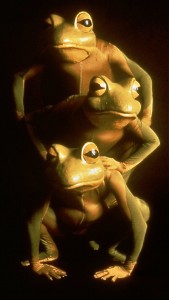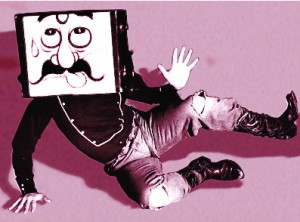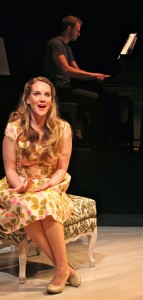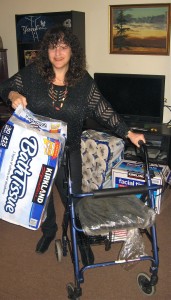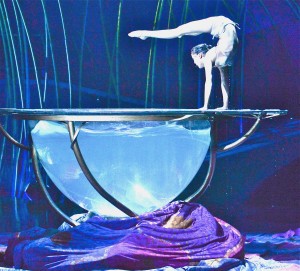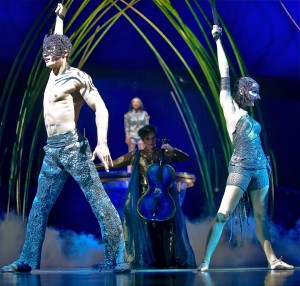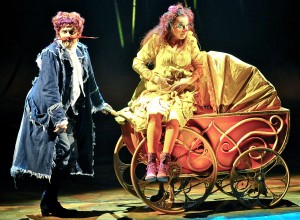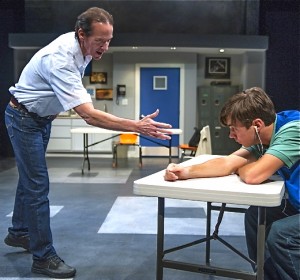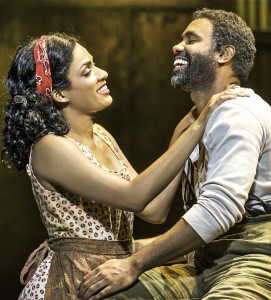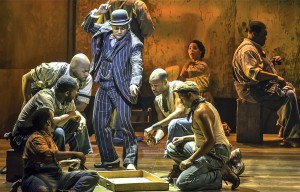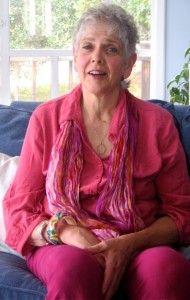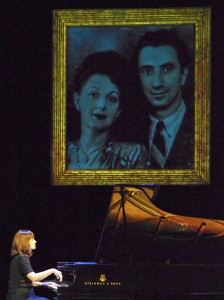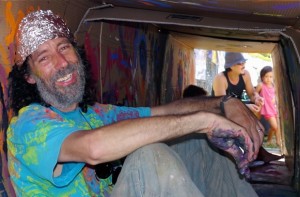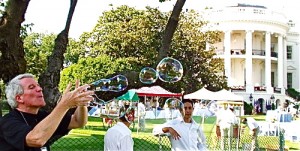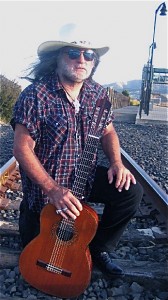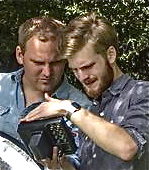Woody’s [rating:5]
Three humans in full frog costumes sit silently at centerstage. They don’t move.
For what seems a long time.
That alone makes much of the audience laugh — most likely in expectation.
When one head finally bobbles, I smile. My wife laughs. Our six-year-old granddaughter giggles aloud.
Moments later, when all three are leap-frogging, stretching via calisthenics and frog-kicking wildly, I smile a bunch, my wife laughs again, and the kid giggles and giggles and giggles.
She also squeals in delight.
And that’s the way it continues, intermittently, for an hour and a half at the multi-costumed, masked Cal Performances show in Berkeley — charming both children and adults in the cavernous, 2,000-seat Zellerbach Hall.
Who says today’s entertainment must be filled with sexploitation, f-bombs or blood and guts?
Not I certainly.
Wholesome family entertainment obviously still exists.
My wife and I had seen the Portland-based Imago Theatre’s signature piece before, years ago. Watching it with the kid made it even more pleasurable.
There were times when it became extremely difficult to decide where our attention should be — on the antics of the five performers or on the delighted face of our granddaughter.
The wordless but musical two-act performance was fantastic, in every sense of that word.
Mostly whimsical. Almost magical.
Momentarily, a viewer might find hints of the mask-mime performers of Mummenschanz, the dancers of Philobolus, the acrobats of Cirque du Soleil or the illusionists of Momix.
Somewhere over the rainbow — perhaps in Kansas, maybe in Brigadoon — there may be another show that features penguins playing musical chairs, sloths that have trouble spelling, papa and mama and baby accordions that move like a Slinky, flittering lights and flying schools of fish, huge balls that momentarily squoosh an equally huge toddler, an alligator and lizard that squirm into the audience, and a singing cowboy with a non-stop changing head.
But I doubt it: “Frogz” is special, one-of-a-kind.
Flawlessly, it blends lively cartoonish characters with imaginative illusions that utilize mime, dance, acrobatics and puppetry.
Carol Triffle and Jerry Mouawad, artistic co-creators, dreamed up the show in the late 1970s. And it’s clear they dreamed in comic relief and primary colors.
The original sound design of Katie Griesar complements their efforts.
Griesar, the program guide acknowledges, “makes music with guitar, antique and toy musical instruments, found objects, collected sounds, wrong notes, and awkward gestures.”
Imago began as a mask theater company, inspired by French mime-actor Jacques Lecoq’s idea that performers could show emotions and characters through moment despite their faces being hidden.
Since its inception, it has performed all over the world — including three Broadway runs.
The troupe also has ventured into purely adult fare such as Harold Pinter’s “The Carpenter,” Anton Chekhov’s “Uncle Vanya” and Jean-Paul Sartre’s “No Exit.”
In case you missed “Frogz,” Cal Performances offers other excellent choices for families. Try, for example, these upcoming show: the Peking Acrobats, Jan. 25 and 26; Michael Cooper’s “Masked Marvels & Wondertales,” Feb. 9; and “Aesop Bops!” with David Gonzalez and the Yak Yak Band, April 6.


